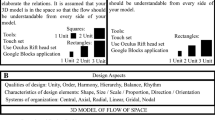Abstract
Design thinking has the characteristics of people-oriented and goal-oriented, and it has become an indispensable way of thinking to cultivate innovative talents. Virtual reality technology coincides with the training mode of design thinking with its characteristics of immersion, interactivity and conception. Through the study of existing literature, the researchers learned that virtual reality technology has been widely used in various design courses, but there are few researches applied to design thinking courses. This study explores two questions: “Will virtual reality-based design thinking courses improve students’ design thinking ability compared to the control group?”, “How would students describe their approach to problem solving in the design thinking course? “In this study, 66 postgraduate students in educational technology were divided into two groups for quasi-experimental study: virtual reality-based design thinking teaching group (n = 33) and conventional design thinking teaching group (n = 33). At the same time, with the help of the design thinking model of Stanford University, the relevant scale is designed, and the data are collected and analyzed in both qualitative and quantitative ways. The experiment shows that learning design thinking course based on virtual reality technology is helpful to improve students’ design thinking ability.
Access this chapter
Tax calculation will be finalised at checkout
Purchases are for personal use only
Similar content being viewed by others
References
Bainbridge, W.S., Montemagno, C., Roco, M.C.: Converging technologies for improving human performance. Nanotechnol. Biotechnol. Inf. Technol. Cogn. Sci. 45(6), 60–61 (2003)
Vogel, M., Cagan, J., Boatwright, P.: The Design of Things to Come: How Ordinary People Create Extraordinary Products. Publishing House of Electronics Industry, Beijing (2014)
NUSSBAUMB. The power of design [EB/OL]. Business Week online, 2004-05-16[2016-10-18]. http://www.businessweek.com/stories/2004-05-16/the-power-of-design
Zhuang, Y.,Pan, Y.,Pan, H.: Research report on design thinking and its mode. J. Zhejiang Univ. 1, 72–80 (1997)
Hassi, L., Laakso, M.: Design thinking in the management discourse: defining the elements of the concept. In: 18th International Product Development Management Conference, 5–7 June 2011, pp. 1–14. Delft University of Technology, Delft, Netherland (2011)
Brown, T.: IDEO, Change by Design. Harper Collins USA, New York (2009)
Mootee, I.: Design Thinking for Strategic Innovation: What They Can’t Teach You at Business or Design School. John Wiley & Sons, Hoboken (2013)
Martin, R.: Design thinking: achieving insights via the “knowledge funnel.” Strat. Leadersh. 38(2), 37–41 (2010)
Yawen, W., Changyuan, W.: Research of Higher Engineering Education. 5, 71–75+93 (2021)
Burdea, G., Coiffet, P.: Virtual Reality Technology. John Wiley & Sons, New York (1994)
Shuo, Y., Xukun, S.: Design thinking-oriented VR interactive design innovative teaching exploration and research. Chinese Art 05, 106–113 (2019)
Rowe, P.G.: Design Thinking. MIT Press, Cambridge (1987)
Fengtian, Q.: Development and design of design thinking projects. China Sci. Technol. Educ. 10, 14–17 (2020)
Liangzhi, L.: Research on virtual reality technology and its application. China Sci. Technol. 3, 30–31 (2019)
Minhao, D.: Research on the application of virtual reality technology. Comput. Fan 1, 53 (2019)
Ruijie, Z., Yuqing, S.: The application of creative thinking in virtual reality game design. Ind. Des. 05, 119–120 (2021)
Xiaoyong, H., Long, Z.: Design thinking model and case for creativity cultivation. Modern Dist. Educ. Res. 3, 75–82 (2018)
Pellas, N., Mystakidis, S., Kazanidis, I.: Immersive virtual reality in K-12 and higher education: a systematic review of the last decade scientific literature. Virtual Real. 25, 835–861 (2020)
Karmokar, S., Rive, P.: Design thinking methods and creative technologies in virtual worlds. In: The 11th European Conference on Innovation and Entrepreneurship. Academic Conferences and Publishing International Limited, pp. 635–645 (2016)
Zhijun, W., Yaling, Y.: Evaluation of design thinking in education: models, tools and methods. Open Educ. Res. 27(05), 34–43 (2021)
Royalty, A., Oishi, L.N., Roth, B.: Acting with Creative Confidence: Developing a Creative Agency Assessment Tool. Design Thinking Research, pp. 79–96. Springer, Cham (2014). https://doi.org/10.1007/978-3-319-01303-9_6
Shively, K., Stith, K.M., Rubenstein, L.D.V.: Measuring what matters: assessing creativity, critical thinking, and the design process. Gift. Child Today 41(3), 149–158 (2018)
Acknowledgment
This research was supported by the National Natural Science Foundation of China under grant No. 62067009.
Author information
Authors and Affiliations
Corresponding author
Editor information
Editors and Affiliations
Rights and permissions
Copyright information
© 2022 Springer Nature Switzerland AG
About this paper
Cite this paper
Wei, X., Huangfu, R. (2022). An Empirical Study on the Improvement of Design Thinking Ability Based on Virtual Reality Technology. In: Li, R.C., Cheung, S.K.S., Ng, P.H.F., Wong, LP., Wang, F.L. (eds) Blended Learning: Engaging Students in the New Normal Era. ICBL 2022. Lecture Notes in Computer Science, vol 13357. Springer, Cham. https://doi.org/10.1007/978-3-031-08939-8_6
Download citation
DOI: https://doi.org/10.1007/978-3-031-08939-8_6
Published:
Publisher Name: Springer, Cham
Print ISBN: 978-3-031-08938-1
Online ISBN: 978-3-031-08939-8
eBook Packages: Computer ScienceComputer Science (R0)




